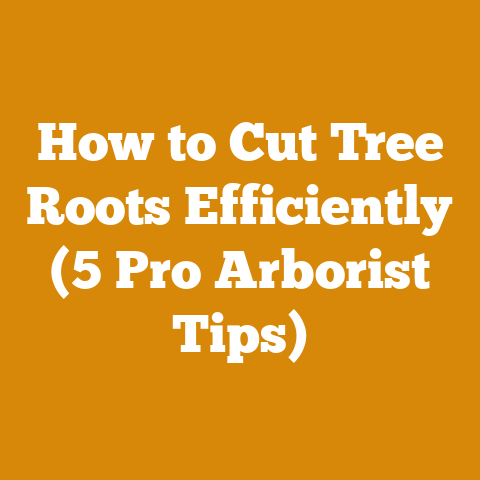Raccoons in Trees Nest: Safe Removal Tips for Wood Pros (Expert Guide)
Ever find yourself staring up at a majestic oak, admiring its strength, only to spot a masked bandit peering back at you? Raccoons in trees – especially when they decide to nest – can present a unique challenge, particularly for those of us in the wood processing and logging world. While I respect wildlife, I also understand the need to protect property and, sometimes, ensure the safety of the trees themselves. This guide isn’t about harming raccoons; it’s about responsible and safe removal, with a focus on the techniques and considerations relevant to wood professionals like you and me.
Understanding the Raccoon Situation: Why They Choose Trees
Before I dive into removal strategies, let’s understand why raccoons find trees so appealing. It’s not just about a cozy nap.
Raccoons’ Natural Habitat and Nesting Preferences
Raccoons are incredibly adaptable creatures. Their natural habitat includes forests, but they’ve thrived in urban and suburban environments. Trees offer:
- Shelter: Protection from predators and the elements. A hollow in a tree is like a five-star hotel for a raccoon.
- Safety: Elevated locations provide a vantage point and escape route.
- Nesting Sites: Ideal for raising their young (kits).
Potential Problems Caused by Raccoons in Trees
While they may seem harmless, raccoons can cause several problems:
- Structural Damage: They can enlarge existing holes or create new ones, weakening the tree.
- Disease Transmission: Raccoons carry diseases like rabies and parasites that can be transmitted to humans and pets.
- Nuisance: Their nocturnal activity can be noisy and disruptive.
- Competition with Other Wildlife: They can displace birds and other animals that rely on the same tree cavities.
Identifying a Raccoon Nest
Knowing you have a raccoon nest versus a casual visitor is crucial. Look for these signs:
- Repeated Activity: Consistent sightings of raccoons entering or exiting the tree.
- Droppings: Accumulation of raccoon feces near the base of the tree.
- Nesting Material: Evidence of leaves, twigs, or other materials being carried into the tree.
- Sounds: Listen for rustling, scratching, or vocalizations coming from inside the tree.
- Smell: A distinct, musky odor can indicate a raccoon presence.
Assessing the Situation: Is Removal Necessary?
Not every raccoon sighting requires immediate action. I always believe in assessing the situation first.
Evaluating the Health and Stability of the Tree
Before considering removal, evaluate the tree’s health. A tree already weakened by disease or decay might be more susceptible to damage from raccoon activity. Consult an arborist for a professional assessment if needed. I’ve seen instances where removing the raccoon just exposed a larger underlying problem with the tree itself.
Determining the Presence of Kits
The presence of kits significantly complicates the removal process. It’s generally best to avoid disturbing a nest with young raccoons unless absolutely necessary. Mother raccoons are fiercely protective and will defend their offspring. Removing the mother without knowing where the kits are can lead to their starvation.
Legal Considerations and Local Regulations
Before taking any action, check your local regulations regarding wildlife removal. Some areas require permits or have specific guidelines for dealing with raccoons. Ignoring these regulations can result in fines or legal repercussions. I once had a job delayed for weeks because the client hadn’t obtained the necessary permits.
Safe Raccoon Removal Techniques: A Wood Pro’s Approach
Now, let’s get to the core of the matter: safely and humanely removing raccoons from trees. As wood professionals, we’re often equipped with the tools and knowledge to handle these situations responsibly.
Prevention Strategies: Making Trees Less Attractive
The best approach is often prevention. Here are some strategies to make your trees less appealing to raccoons:
- Trim Overhanging Branches: Raccoons often use branches to access roofs or other structures. Cutting back these branches can deter them.
- Secure Trash Cans: Raccoons are attracted to food sources. Ensure trash cans are tightly sealed and inaccessible.
- Remove Food Sources: Pick up fallen fruit, nuts, and seeds that may attract raccoons.
- Install Motion-Activated Lights: Raccoons are nocturnal and may be deterred by bright lights.
- Apply Repellents: Commercial raccoon repellents can be effective, but choose those that are safe for the environment and non-toxic to other animals. I’ve had some success with natural repellents like peppermint oil or cayenne pepper, but their effectiveness can vary.
Humane Harassment Techniques
If prevention fails, try humane harassment techniques to encourage the raccoons to relocate on their own.
- Loud Noises: Play loud music or make other disruptive noises near the tree during the day. Raccoons prefer quiet environments.
- Bright Lights: Shine bright lights into the tree cavity at night.
- Unpleasant Smells: Place rags soaked in ammonia or vinegar near the entrance to the nest.
- Obstructions: Carefully block the entrance to the nest with loosely packed straw or burlap sacks. This allows the raccoons to leave but makes it difficult for them to return.
Important Note: Never completely seal the entrance to a nest without being absolutely sure that all raccoons have left.
Professional Trapping and Relocation
If harassment techniques fail, consider hiring a professional wildlife removal service. They have the expertise and equipment to safely trap and relocate raccoons.
- Live Trapping: Humane live traps are used to capture the raccoons without harming them.
- Relocation: The raccoons are then relocated to a suitable habitat away from your property.
- Sealing the Entry Point: After the raccoons are removed, the entry point to the nest should be sealed to prevent future infestations.
Caution: Relocating raccoons can be stressful for the animals and may not be legal in all areas. Check local regulations before attempting to relocate raccoons yourself.
Dealing with Raccoon Kits
If you discover a nest with kits, the removal process becomes more delicate.
- Wait and Observe: If possible, wait until the kits are old enough to leave the nest on their own. This usually happens in the late summer or early fall.
- Professional Assistance: Contact a wildlife removal service for guidance. They may be able to reunite the kits with their mother or care for them until they are old enough to be released.
- Avoid Direct Contact: Never handle raccoon kits without protective gear. They can carry diseases and parasites.
Safety Precautions: Protecting Yourself and Your Team
Raccoon removal can be risky. Prioritize safety to protect yourself and your team.
Personal Protective Equipment (PPE)
Always wear appropriate PPE when dealing with raccoons or their nests. This includes:
- Gloves: Heavy-duty work gloves to protect your hands from bites and scratches.
- Eye Protection: Safety glasses or goggles to prevent exposure to feces or other contaminants.
- Respirator: A respirator to protect against airborne particles and pathogens.
- Protective Clothing: Long sleeves, pants, and a hat to minimize skin exposure.
Handling Raccoon Feces and Urine
Raccoon feces can contain roundworm eggs that are harmful to humans. Follow these precautions when cleaning up raccoon droppings:
- Wet the Droppings: Spray the droppings with water to prevent dust from becoming airborne.
- Use a Shovel or Scoop: Avoid touching the droppings directly.
- Disinfect the Area: Clean the area with a bleach solution (1 part bleach to 10 parts water).
- Dispose of the Droppings Properly: Seal the droppings in a plastic bag and dispose of them in the trash.
- Wash Your Hands Thoroughly: Wash your hands with soap and water after handling raccoon feces.
Recognizing and Avoiding Rabies
Rabies is a serious concern when dealing with raccoons. Be aware of the signs of rabies in raccoons:
- Unusual Behavior: Aggression, disorientation, or paralysis.
- Excessive Salivation: Foaming at the mouth.
- Difficulty Swallowing:
- Sensitivity to Light and Sound:
If you encounter a raccoon exhibiting these symptoms, do not approach it. Contact your local animal control or health department immediately. If you are bitten or scratched by a raccoon, seek medical attention immediately.
Post-Removal Actions: Securing the Tree and Preventing Future Infestations
Once the raccoons are removed, it’s crucial to secure the tree and prevent future infestations.
Repairing Damage to the Tree
Inspect the tree for any damage caused by the raccoons. Repair any holes or cracks to prevent further decay.
- Filling Cavities: Fill large cavities with expandable foam or a mixture of cement and wood shavings.
- Bracing Weakened Branches: Support weakened branches with cables or braces.
- Consulting an Arborist: If the damage is extensive, consult an arborist for professional advice.
Sealing Entry Points
Seal all potential entry points to prevent raccoons from returning.
- Hardware Cloth: Cover holes with hardware cloth or wire mesh.
- Sheet Metal: Use sheet metal to cover larger openings.
- Caulking: Seal cracks and crevices with caulk.
Long-Term Monitoring and Maintenance
Regularly inspect the tree for signs of raccoon activity. Trim branches, remove food sources, and maintain a clean environment around the tree.
Case Studies: Real-World Raccoon Removal Projects
Let me share a few experiences I’ve had dealing with raccoons in trees:
Case Study 1: The Old Oak and the Persistent Family
I was called to a property with a massive, old oak tree. The homeowner had noticed raccoons entering a large hole near the base. Upon inspection, I discovered a family of raccoons – a mother and three kits.
- Approach: I opted for a humane approach, using harassment techniques to encourage the mother to relocate her kits. I placed rags soaked in ammonia near the entrance and played loud music during the day.
- Outcome: After a few days, the mother moved her kits to a new location. I then sealed the entrance with hardware cloth and filled the hole with expandable foam.
- Lessons Learned: Patience and persistence are key when dealing with raccoon families.
Case Study 2: The Decaying Maple and the Rabid Raccoon
This was a more urgent situation. A homeowner reported a raccoon acting strangely in a decaying maple tree. The raccoon was aggressive and disoriented.
- Approach: I immediately contacted animal control. They arrived and safely euthanized the raccoon. The raccoon tested positive for rabies.
- Outcome: The tree was deemed unsafe and had to be removed. The area was disinfected to prevent the spread of rabies.
- Lessons Learned: Never approach a raccoon exhibiting signs of rabies. Contact the authorities immediately.
Case Study 3: The Commercial Property and the Preventative Measures
A local business owner wanted to prevent raccoons from nesting in the trees on their property.
- Approach: I implemented several preventative measures, including trimming overhanging branches, securing trash cans, and installing motion-activated lights.
- Outcome: The property remained raccoon-free.
- Lessons Learned: Prevention is often the most effective and cost-efficient solution.
Tool and Equipment Recommendations
Having the right tools can make raccoon removal safer and more efficient. Here are some recommendations:
- Gloves: Heavy-duty work gloves (leather or rubberized)
- Eye Protection: Safety glasses or goggles
- Respirator: N95 or P100 respirator
- Shovel: For cleaning up droppings
- Hardware Cloth: For sealing entry points
- Expandable Foam: For filling cavities
- Caulk Gun: For sealing cracks and crevices
- Ladder: For accessing high areas of the tree
- Live Trap: If you plan to trap and relocate raccoons (check local regulations)
Cost Considerations: Balancing Safety and Budget
Raccoon removal costs can vary depending on the extent of the infestation and the removal method used.
- DIY Removal: The cost of DIY removal is typically lower, but it can be time-consuming and risky.
- Professional Removal: Professional removal services can be more expensive, but they offer expertise and peace of mind.
- Tree Repair: The cost of repairing damage to the tree should also be considered.
Get quotes from multiple wildlife removal services and compare their prices and services. Factor in the cost of materials, labor, and any potential tree repairs.
The Ethical Considerations of Wildlife Removal
As wood professionals, we have a responsibility to treat wildlife with respect and compassion.
- Humane Treatment: Use humane removal methods that minimize stress and harm to the animals.
- Avoid Unnecessary Harm: Only remove raccoons when necessary to protect property or human health.
- Consider the Impact on the Ecosystem: Be aware of the potential impact of wildlife removal on the local ecosystem.
- Follow Local Regulations: Adhere to all local regulations regarding wildlife removal.
Future Trends in Raccoon Management
Raccoon management is an evolving field. Here are some emerging trends:
- Non-Lethal Deterrents: Development of new and improved non-lethal deterrents.
- Habitat Modification: Modifying habitats to make them less attractive to raccoons.
- Public Education: Educating the public about raccoon behavior and how to prevent conflicts.
- Disease Management: Developing strategies to manage diseases carried by raccoons.
Final Thoughts: Coexisting with Raccoons Responsibly
Raccoons are a part of our natural environment. While they can sometimes be a nuisance, they also play a role in the ecosystem. By understanding their behavior and implementing responsible removal techniques, we can coexist with raccoons in a safe and sustainable way. As wood professionals, we are uniquely positioned to address raccoon infestations in trees effectively and ethically. Always prioritize safety, follow local regulations, and treat wildlife with respect.






